West Coast Road Trip
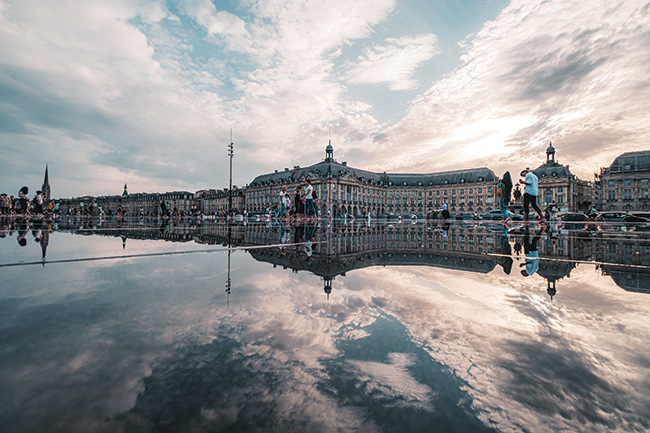
From the granite grandeur of southern Brittany to the glories of Landes: long-time resident Annaliza Davis explains why the west coast offers one of the great French road trips.
Heading south to reach a destination is one thing; making a road-trip along the west coast is a completely different experience. Ideally you’d take your time on the meandering side roads, but even France’s motorways will showcase terracotta rooftops, vast rolling vineyards, yawning bucolic landscapes and the sparkling Atlantic, plus some bonus lakes, rivers and streams. This is one of the best routes from north to south, offering regular changes of scenery and a real flavour of the diversity of French culture, its architecture, art, heritage and abundant gastronomic delights. So what are we waiting for?
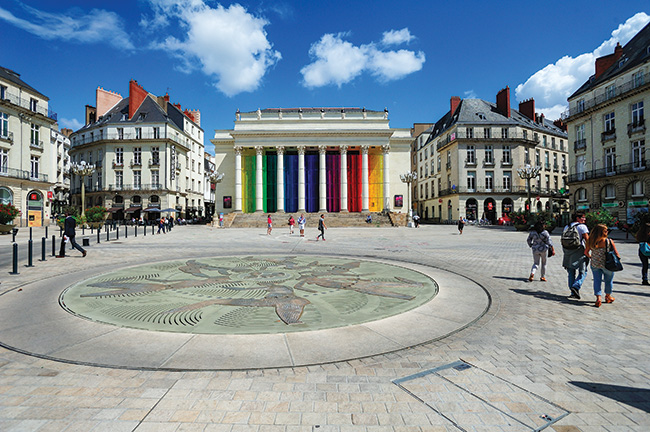
Théâtre Graslin in Nantes’ Place Graslin © Yannick Le Gal
Day 1: Nantes
Our starting point is Nantes, the gateway where Brittany meets the Pays de la Loire, a strategic location that has ensured its key role in France’s history. Now a dynamic and diverse university city of 300,000 residents, Nantes carries its status with ease, balancing centuries-old heritage and contemporary art, protecting the old while embracing the new. This is a destination with sigh-worthy architecture at its heart, yet it manages to keep an undercurrent of youthful vibrancy that is sure to sweep you along.
Here’s a question that the French will hotly debate: is Nantes part of Brittany? Nowadays, the official answer is no, as it became part of Pays de la Loire following the Second World War, but for centuries it was the Breton capital and home to the region’s royal family. Indeed, just last year the council voted for a referendum to allow this part of France to return to Brittany, so the debate continues!
This curious duality explains why Nantes is in the département of Loire-Atlantique (named after the River Loire and the Atlantic Ocean), yet is simultaneously home to the Château des Ducs de Bretagne, a fabulous structure in the heart of the city, surrounded by lawns where office-workers take their lunch breaks. Dating from the 1400s and 1600s, the château offers everything you’d hope for: imposing fortified towers, a moat and granite ramparts, as well as sweeping staircases, elongated windows and, from the inner courtyard, a façade of near-white Tuffeau stone, gleaming in its grandeur thanks to extensive restoration work. Once home to Anne de Bretagne, the château now houses the city’s museum, so you can explore the beautiful rooms and learn some history along the way, or you can simply meander around the grounds for free, enjoy a drink in the courtyard and imagine the lives led by the dukes who once lived in this imposing property.
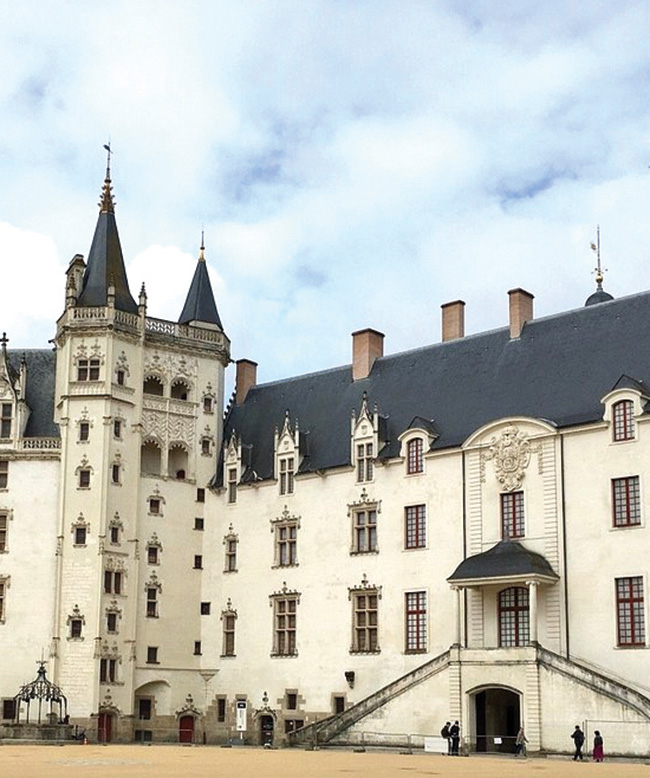
The Château des Ducs de Bretagne in Nantes © Cil Via
A City Packed with Interest
Art-lovers will be perfectly content browsing the city’s art-supply stores, central galleries and boutiques, and especially the Musée des Beaux-Arts as it offers a broad and diverse range, with 900 works in the permanent collection as well as temporary exhibitions showcasing particular themes or artists.
Many other galleries and small artistic boutiques are dotted throughout the city, such as L’Atelier, a beautiful building dating from the 1860s and a gallery since 2008. Located on rue Châteaubriand, it’s very central and is a great spot to enjoy photography and modern art. As surreal as French art can be, Les Machines de l’Île takes the experience to a whole new level of playfulness, uniting the artistic and fictional with science-fiction and engineering. It’s located on a river island within the city, accessible by bridges, a once industrial site that has been regenerated to offer cafés, restaurants and larger-than-life mechanical animals inspired by the works of Jules Verne, who was born in Nantes in 1828. Visitors can explore the workshops, but the star of the show is the 12m-tall elephant that squirts water at the crowd, while kids will adore the carousel of underwater creatures. This truly is an unforgettable and rather magical place to visit, whatever your age.
One of France’s top botanical gardens is in the heart of Nantes: Le Jardin des Plantes. Its 17 acres of lush greenery include a 800m² glasshouse, 10,000 species of plants and 50,000 flowers planted every year. These gardens have open arms: the topiary has a real sense of fun, as do the artist-designed sculptures and children’s areas, so you feel invited to stroll and relax. Incredibly, this entire site is free to visit.
For additional heritage highlights, head to the Bouffay district to lose yourself in the winding narrow streets sprinkled with half-timbered buildings and cafés that are ideal for people-watching. And you must see the Passage Pommeraye, a surprising little indoor shopping arcade from the 1800s, complete with glass roof, balustrades and sculptures, and Place Graslin, a beautiful town square with curved Regency buildings and a fountain, as well as the city’s opera house.
Also on Place Graslin, you’ll find the irresistible brasserie La Cigale, whose stunning Art Nouveau interior alone makes it well worth booking a table. Even if you only have the budget for a morning coffee, do try to go there, because you’re sure to be enchanted by its beauty. There’s also plenty for vegan and vegetarian diners, and low-budget and quick snack options, no doubt thanks to the large student community based here.
Nantes with a P?
As you stroll around Nantes, you may notice some house numbers include the letter P. Dating back at least 200 years, it showed there was a well (puits in French) on the spot – which was very handy in the event of fire.
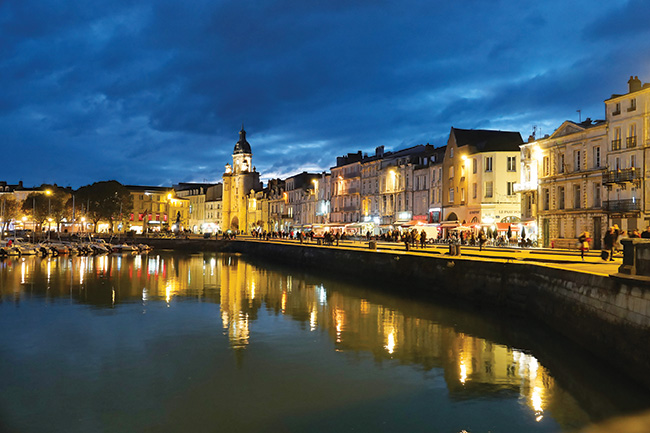
La Rochelle’s glittering Old Port at night © Charente Tourisme
Day 2: Nantes – La Rochelle – Saintes
216km – 2 hr 45 – €14 tolls
Leaving Nantes after breakfast, head south on the A83 to arrive in La Rochelle for lunchtime.
La Rochelle
This famous harbour city is bursting with character, higgledy-piggledy rooftops, medieval houses and quaint passageways that are delightful to explore.
One of the best spots for lunch is the Old Port: choose one of the pavement cafés here and soak up the atmosphere, listening to the ping of the masts on nearby boats, the chatter of passers-by and the cries of the gulls swooping overhead.
If you prefer a spot away from the hustle and bustle, simply walk along Rue des Templiers, where you’ll find several inexpensive French and Italian eateries, or drop into Le Garden Café at no. 24 for one of its tempting salad platters.

A quayside café in La Rochelle © Charente Tourisme
You can easily lose hours browsing independent boutiques, enjoying the impromptu exhibitions, live music and an occasional flea market. In the event of chilly or overcast days, visit the Maritime Museum to explore real boats or the nearby Aquarium La Rochelle, which has a deservedly excellent reputation and offers signs in English.
If the weather’s fine, it’s a short walk to Parc Charruyer, a beautifully-maintained haven of 98 acres where you can cool down by the water and watch peacocks, swans and several small farm animals. Best of all, it’s free to visit and a great place to relax. Also take time to explore the medieval alleyways, timbered buildings and the Dames Blanches cloisters, dating back to the 1600s. The Town Hall is one of France’s finest, dating from 1298 – although it incorporates sections from most eras in between and has been fully restored twice.
La Grosse-Horloge (the big clock) marks the site of a former boundary wall between the town and the port. It continues to serve as an entranceway to the central streets and is a fairly unmissable landmark dominating the skyline, wherever you are in the town.
Once you have explored the pedestrian streets of La Rochelle and snapped up a few mementoes, it’s time to continue to Saintes, one hour to the south.
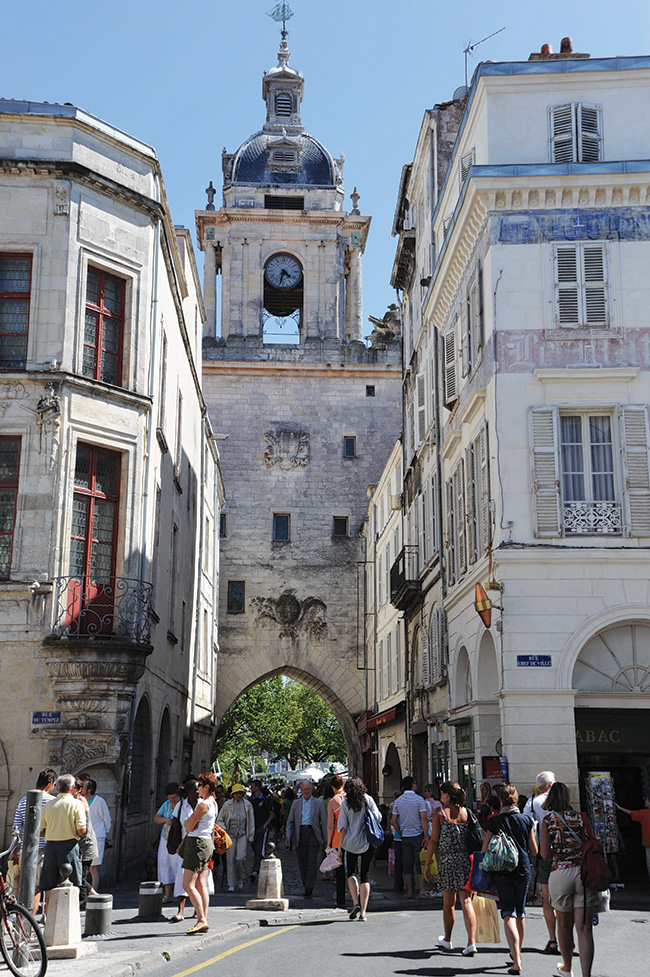
La Grosse-Horloge is a famous local landmark
Saintes
Often overlooked, Saintes is a seductive town with picturesque streets and the broad Charente river forever flowing. Follow a leisurely walk along the riverbanks and you’ll be tempted to take up the offer of a lazy boat trip, as the water looks so inviting.
Rising above the horizon, the tower of Saint-Pierre Cathedral is unlike any other, earning it the unfortunate nickname of ‘the unfinished’. Its bell-tower was never fully completed, and if you look at it from a distance you’ll notice that the proportions suggest a far taller edifice, giving it a surprisingly stunted appearance. It is actually topped off by a metal dome rather than the more conventional soaring spires, but it manages an impressive 58m height nevertheless. This has been a site of worship since the Middle Ages, with the cathedral dating from the 1200s and 1400s, a celebration of flamboyant Gothic style.
Overlooking the entire town is Saintes’ Basilica Saint-Eutrope. As with stained glass, sculptures were often used to tell stories to non-literate church-goers, so the recent restoration brought 13 new sculptures, which include references to the Covid pandemic, thereby bringing the building right up to date.
It’s possible to go even further back in time, with a visit to the amphitheatre remains. Free for under-18s and €4 for adults, this oval structure could have welcomed several thousand people in the first century AD, when Saintes was known as Mediolanum.

Bordeaux, Place de la Bourse
Day 3: Saintes – Bordeaux – Hossegor
289km – 3 hours – €21 tolls
After enjoying breakfast in Saintes, it’s time to take the A10 down to Bordeaux, a port-side city boasting an incredible tally of 350 listed monuments but also strikingly contemporary structures such as the Méca creative and cultural centre.
The iconic town square, Place de la Bourse, was designed in the 1700s by the King’s own architect, Jacques Gabriel, which explains its impact and regal grandeur. In 2006, the Miroir d’eau was installed: 3,450m² of water just 2cm deep that mirrors the Classical symmetry of the Customs House. You’ll immediately understand why this is one of the city’s most photographed locations, particularly at night.
Once you’ve saturated your senses in Bordeaux, it’s time to drive the remaining two hours south through the landscapes of Les Landes and on to Hossegor.
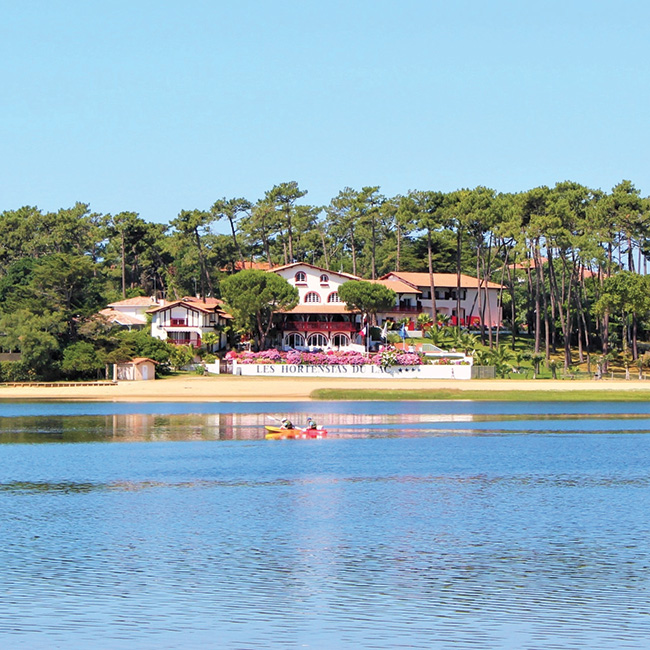
Hôtel Les Hortensias du Lac in Hossegor
Hossegor
Synonymous with beach life, Hossegor is famous as the European surf capital, attracting surfers and artists for more than a century. It still has a Bohemian, eclectic feel that’s a perfect match for lazy, sunny days enjoying the best that French life has to offer.
Its international surf appeal is reflected in the town: Hawaiian-themed shops, tones of turquoise and white in the décor – this sport has absolutely soaked into the personality of the town. Hardcore fans head to Pédebert’s factory outlets bursting with boards, wetsuits, professional shapers offering tailor-made boards, and accessories for every water sport imaginable. You can catch waves almost anywhere here, but la Gravière and la Nord are world-renowned thanks to their location near the Capbreton Gulf. There are plenty of surf schools with qualified instructors ready to teach you all about the currents, waves and techniques. Group lessons start at €35 for 90 minutes.
As a side note, some would say that Hossegor is also more about the genuine love of the sport rather than certain other surf destinations that can get caught up in the image and the fashion of surfing.
Certain beaches offer a lifeguard presence in high season – la Gravière, la Centrale, la Sud – making them a top choice for family days out, while another is a naturist spot, which is appropriately and affectionately known by the locals as ‘the bare-bum beach’.

The West Coast is a seafood lover’s delight © La Brasserie La Cigale
Lakeside in Hossegor
The captivating lake here changes with every hour of the day, connected to the ocean by a canal and shifting with the tides. You can stroll the whole way around the lake thanks to a 7.4km path that also takes you past several enviable villas, typical of the Basco-Landaise architecture. It’s also an idyllic spot for stand-up paddleboarding – known in France as SUP – as the tides are far more gentle than out on the open water, and you’re not crowded by people doing more adrenaline-fuelled watersports.
At one end of the lake, you’ll probably notice curious little huts known as cabanes ostréicoles, where you will see fresh oysters on offer, ready to slurp along with a cool glass of white wine. Or you can just enjoy the wine.
Also lakeside is Le Mango Tree, open from breakfast to sundown, bursting with fresh fruit, vibrant colours and healthy but enticing vegetarian burritos, homemade pastries, organic shakes and smoothies, so the only limit is your appetite. As always in France, notice how the cuisine changes with the landscape.
Along the whole coast, you’ll glimpse sea salt being gathered by hand, and also oyster beds as this is a chef’s heaven for seafood platters, lobster and mussels, as well as local markets bursting with fresh fruit and veg. Of course, foie gras and pork rillettes are ever-present, as are the ubiquitous cheeses, notably goat’s cheese and Tomme de Vendée. If you have a sweet tooth, you’ll be spoilt for choice: butter biscuits, intricate apple tarts, custard-filled pastries, melt-in-the- mouth fruit tarts, and hand-crafted chocolate creations in every shape and size. Just remember to leave room in the car to take some home with you!
From France Today magazine
Lead photo credit : The Miroir d’eau in Bordeaux © Teddy Verneuil
Share to: Facebook Twitter LinkedIn Email
More in Brittany, La Rochelle, Nantes, Vendée
Leave a reply
Your email address will not be published. Required fields are marked *



